Samsung Galaxy S 5 Review
by Anand Lal Shimpi & Joshua Ho on April 8, 2014 12:00 AM EST- Posted in
- Smartphones
- Samsung
- Mobile
- Galaxy S 5
Display
As the smartphone market continues to mature, the distinguishing between smartphones becomes harder and harder as OEMs continue to converge in platform and in most other aspects. This is most evident when looking at the progression from the Galaxy S2 generation to today. Back then, the Galaxy S2 was notable because of its Exynos 4210 SoC, which was far ahead of Qualcomm’s dual core Scorpion solutions at the time, which meant non-Samsung OEMs had notably worse CPU and GPU performance. The same was also true for the original Galaxy S with its Hummingbird SoC. Today, just about every OEM ships the same SoC. The difference between 8974AB and 8974AC is effectively only an eight percent CPU bump for the AC variant.
One of the key differentiators now in the market is display. The Galaxy S 5 features a 5.1-inch 1080p Full HD Super AMOLED display, equipped with the usual set of software defined color profiles. The GS5 gets a new adaptive profile that automatically adjusts the tint of the display according to the color of the ambient light. It's a neat effect, however Samsung's Cinema mode still ends up being the most accurate.
As always, we measure color accuracy using Spectracal’s CalMAN 5 software and a custom workflow for smartphones and tablets.
The results show that the Galaxy S5 has a display that is dramatically improved from the Galaxy S4. However, the Galaxy S line doesn’t exist in a vacuum, so it’s important to also look at how it compares against the best LCDs in other phones. In this department, things aren’t quite as perfect. To start, the color gamut control is still rather poor even on Cinema mode, as effectively all of the secondary colors miss the sRGB targets for saturation sweep. Yellow, cyan secondaries and green primaries are also notably out of the sRGB gamut triangle. While recent headlines have raved about the Galaxy S5’s record-setting color accuracy, I don’t see this at all in the results. Still, against the competition in the Android space, Samsung has improved a tremendous amount while other OEMs seem to be stagnating or even regressing in color accuracy. The only Android OEM that actually beats Samsung in the color accuracy department is now Google, which is strange because they contract out their hardware to other Android OEMs.
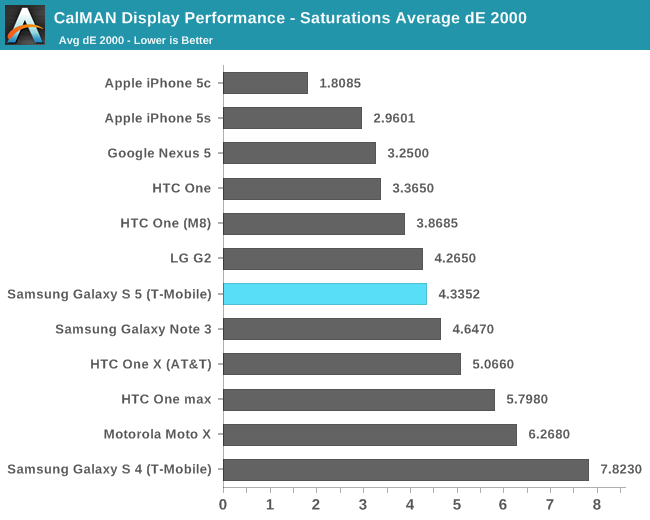
Looking at the saturation sweep, it’s evident that Samsung is now about equivalent to LG in color accuracy for their displays. HTC is barely ahead, with such a small difference that it’s not worth counting. Only Google and Apple have a noticeable lead in this department, a huge improvement from 2013 when Samsung trailed far behind most other competitors in this test.
In the Gretag Macbeth Colorchecker, Samsung continues to hold its position, beating all but Google and Apple. HTC is noticeably behind in this department compared to Samsung, as the One (M8) is horrific in this department compared to even the original HTC One.
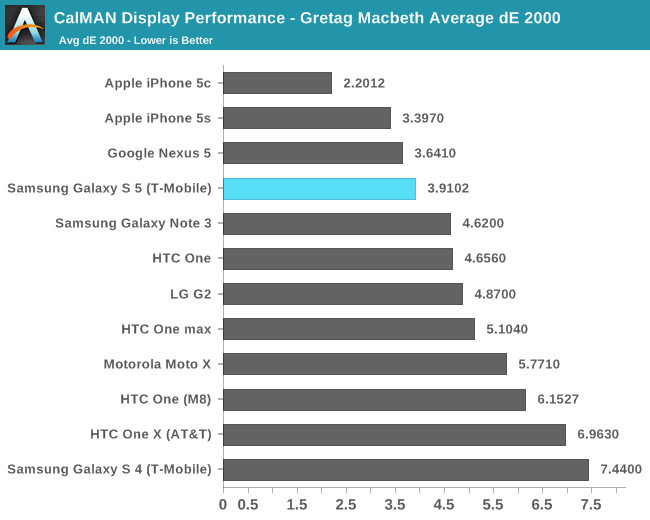
In the contrast department, Samsung continues to dominate, with effectively infinite contrast. Based upon some quick viewing of the display in the darkest room I have in the house, I don’t see any obvious DC bias issues. Unfortunately, I still see some ghosting on the display at low brightness which manifests as a purple trail when scrolling. This seems to be unchanged from the Galaxy S4. The minimum white brightness is around 1.8 nits, which is great for reading at night, as many LCD-screened phones such as the LG G Pro 2 have a minimum white brightness of around 7-12 nits.
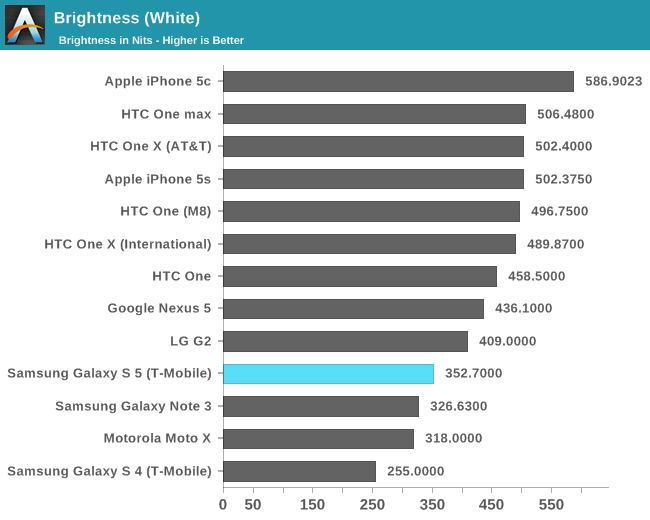
Samsung has also made great gains in the maximum brightness department, which is especially pleasing because for the longest time, AMOLED was noticeably less bright which made it incredibly difficult to read webpages and similar content outdoors. I’m happy to say that this is no longer the case, as the Galaxy S5 now has a display that realistically reaches around 440 nits outdoors with a pure white image, although this requires auto-brightness to be on and will vary with the screen mode. The maximum that is accessible without this daytime boost mode is somewhere around 350 nits.
The problem is the way Samsung has achieved this, something that is shown in the grayscale tests. While Samsung has done a great job in clamping down the white point to around 6504k, grayscale is so noticeably green that not only does CalMAN show this in the measurements, but also casual observation. I can literally see that the grayscale image is not gray, but an off-green. I’m not quite sure how this happened, but I suspect that this was done in an effort to increase peak brightness as even in the bluest display mode, green is still closely tracking with blue.
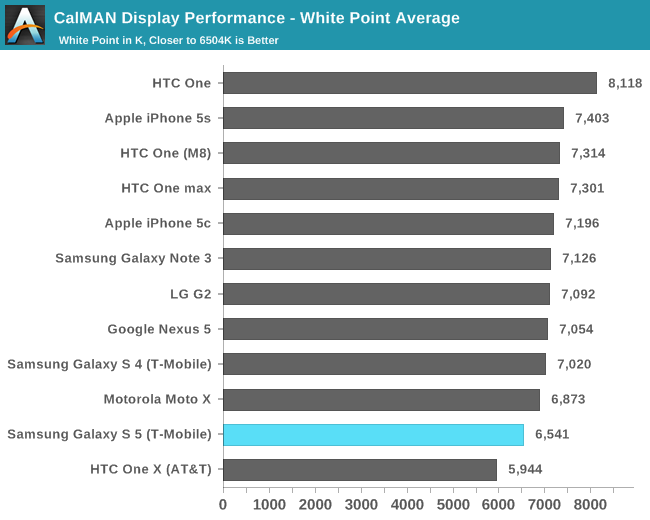
Overall, I’m quite pleased with the display. The AMOLED display in the Galaxy S5 is finally equivalent to LCD displays in color accuracy and peak luminance, areas that LCD used to be the best in. Throw in the incredible contrast that AMOLED has always had and the ability to toggle between wide color gamut and accurate color, and I would say that AMOLED is finally equal, if not slightly better than LCD. With a few more iterations, I wouldn’t be surprised if I were to write that AMOLED is clearly superior to LCD. Of course, there are some issues such as a noticeable green tint to the display in grayscale and Samsung still needs to improve their clamping of gamut to sRGB for Cinema/Movie mode, but none of these issues seriously detract from the viewing experience.


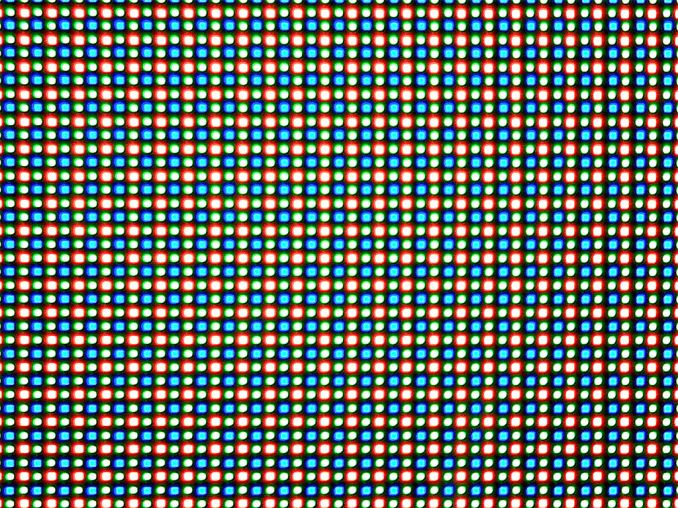












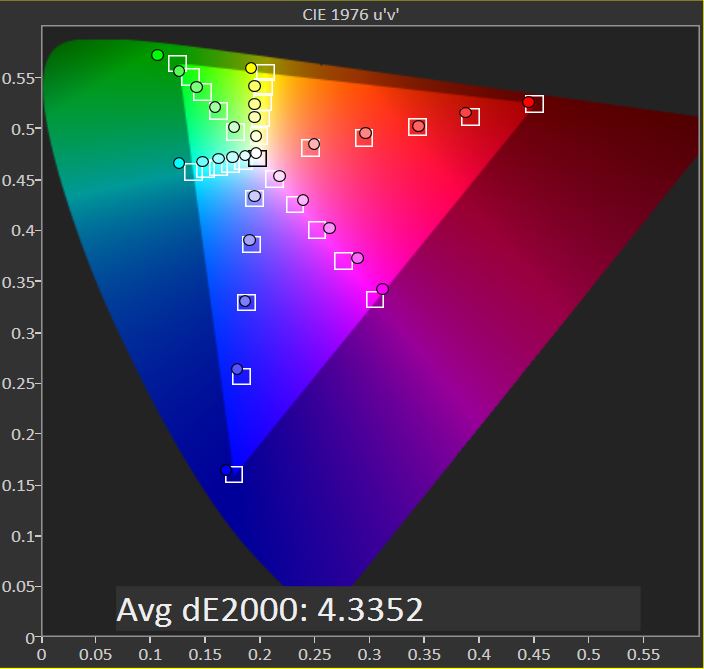
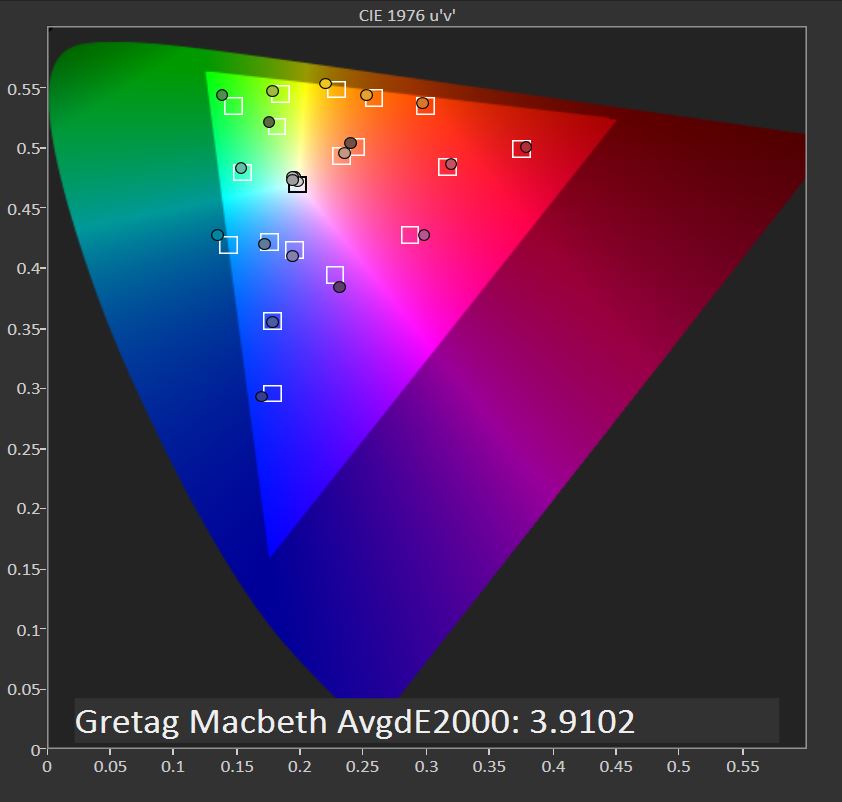









296 Comments
View All Comments
theduckofdeath - Wednesday, April 9, 2014 - link
If you don't understand what Android is, I really don't see why I should discuss it with you.Android is a free to use open source platform. This means, manufacturers has to compile the code to their specific hardware, which takes a few months. NO ONE IN THE REAL WORLD CARES ABOUT THIS DELAY NIVA. NO ONE.
People who are been obsessed with stock experience pushed to their phones the minute Google announces a new update buy a Nexus phone. Everyone else buys the phone they feel best suits them. Most people teds to buy Galaxy S phones, simply because they are the best, and one of the very few with an OLED display.
Skinning Android is a necessity to create a feeling of an ecosystem the buyer feels at home with. For instance, I could never live with the skin Sony crams into their phones, in my opinion it's ugly in really incoherent. I have a Nexus tablet too, but I prefer TouchWiz, simply because it gives you a lot of really, really useful add/on features.
Anyone arguing a Nexus phone is the only choice, just because it has stock Android doesn't understand what a smartphone is. The Nexus 5 is a mediocre phone. At best.
jezzgoodwin - Wednesday, April 9, 2014 - link
I have to agree with the parents here. The Samsung Touchwiz UI suffers from lots of stuttering when in motion. When doing simple things like sliding between home screens, there is stutter.My friend has an HTC One which has a different UI and his phone is really smooth when doing transitions.
The Samsungs are brilliant phones, but they should really fix the stutter.
theduckofdeath - Thursday, April 10, 2014 - link
Try putting the exact same widgets on those two phones when you scroll. TouchWiz doesn't stutter from simple scrolling. However all operating systems stutter for instance when information has to be swapped from storage to RAM. Even my 8GB quadcore Haswell desktop PC does that fairly often.You should really try one out for real instead of basing your ideas off something you've basically read on a forum on the internet.
Kidster3001 - Wednesday, April 30, 2014 - link
Just use a different launcher from Touchwiz. My Note2 struggles a little in Touchwiz. I use Nova Launcher now and everything is much smoother. No root required, just install it and set as default launcher.Latzara - Wednesday, April 9, 2014 - link
pls --- a Nexus is on par with the currently leading phones for about 2/3 of the price -- that doesn't a mediocre phone make. And the usefulness of the Touchwiz addons is completely subjective -- had a Galaxy S and an SIII and in both cases it wasn't long till i flashed a custom ROM to get rid of all the crammed in usefulness...Don't paint a product with your personal experience and then extrapolate to everyone else. It just doesn't work that way and if you had any intention of being fair you'd know that. I don't like Touchwiz. Some do (i.e. you) but you can't argue that they add a bunch of apps that aren't directly tied to core functionality (like messaging for example which can't be removed) without even giving you a choice to uninstall what you deem unnecessary .... Lack of choice is always a grade down for me. I don't need the multitude of hubs for this and that and i can't get rid of them.
and btw, on the "NO ONE IN THE REAL WORLD CARES ABOUT THIS DELAY NIVA. NO ONE." part -- there is a large modding community that begs to differ ...
theduckofdeath - Thursday, April 10, 2014 - link
The Nexus phones are nice. But they are not on par. They're good value high/end phones, where the manufacturers cuts corners on pretty important things like display quality, camera and other things that are not easy to present in tech specs but are pretty obvious when you use them.Max(IT) - Saturday, April 19, 2014 - link
You are right, nexus aren't on par: they are better. When it comes to build quality, Samsung's devices disappear. A nexus 5 is far better build than a 700$ Galaxy S5 ....The nexus 5 isn't perfect, for sure. Battery and camera aren't the best on the market, but still is superior to any Galaxy S .... at a lower price point.
Stock Android makes it fast and responsive, without tons of gimmicks added by Samsung.
The only Samsung I would consider is a GPE.
theduckofdeath - Friday, April 25, 2014 - link
Build quality is better in the Nexus 5? Just because it's different materials, it definitely does not mean it's better built. The GS5 is IP67 certified, which actually requires higher precision and build quality than, you know, no IP certification.... :)DiHydro - Friday, April 25, 2014 - link
I work for a company that has IPX certified our products just this year, and I know first hand that IPX certification does not account for build quality or materials. I could get a cellphone made with cardboard and cellophane tape IP67 certified. This doesn't mean it is durable or well made.Kidster3001 - Wednesday, April 30, 2014 - link
I'd much rather have my plastic phone that bounces a little than a metal one. My personal opinion.